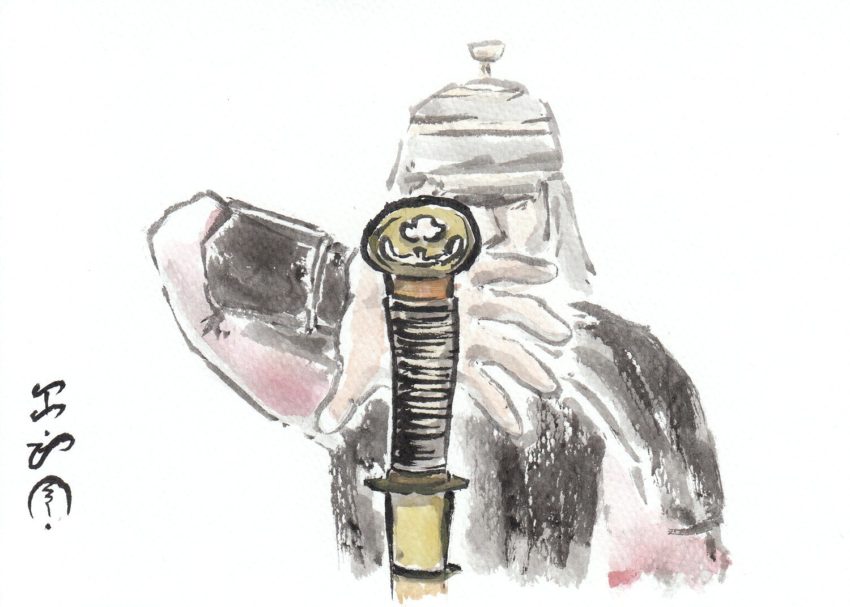The enduring tradition of Japanese sword-making has ancient roots. Although the contemporary version of the Japanese katana remains the most recognizable to outsiders of Japanese culture, many variations of the ancient Japanese samurai sword developed alongside the way of the Japanese warrior. In fact, a lesser-known part of Japanese weapon history is the existence of shorter swords with straight blades.
Distinguishing Characteristics of Very Early Swords
The oldest ancient Japanese sword looked quite different to a katanaKATANA 刀 "sword" learn more.... Instead of a curved blade, the first swords, known as chokutoCHOKUTO 直刀 "straight sword" learn more..., had straight blades with one cutting edge. These swords were most likely made in China and traveled to Japan as a result of trade with Korea.
Why were early swords bereft of the classic curved blade that it considered so typically characteristic of Japanese swords? Early swords were made for good, old-fashioned slashing and stabbing. Although the blade is not as sophisticated as later Japanese swords, the quality does match the general purpose of the weapon. The handles of chokuto swords matched well with the other basic elements, with few embellishments and enough space for a one-handed grip.
However, as Japanese blacksmiths began to perfect the art of sword-making themselves, new forms of weaponry arose. The tsurugiTSURUGI 剣 "sword [non-Japanese]" learn more... or kenKEN 剣 "sword [non-Japanese]" learn more... were also straight-bladed swords, but had two (not one) cutting edges, unlike later swords. Double-edged swords such as these may have been transitional forms in the eventual development of the famous curved blade.
The Flow of History: Developments in Early Blades
Developments in ancient Japanese sword technology reflect movement in history. Perhaps the greatest push for the creation of better swords would be the concurrent development of a highly sophisticated and honor-bound warrior class: the samuraiSAMURAI 侍 "warrior serving a lord" learn more.... As methods of warfare changed over time, new types of weapons developed to increase the chances of winning in a fight. Although Japanese swords are known for their deadly beauty, there was always at first high value placed on the overall functionality of a weapon.
Japanese Swords Before 900 AD
Swords made prior to the year 900 AD are considered to be from the Jokoto Period. JokotoJOKOTO 上古刀 "pre-900 AD swords" learn more..., meaning “ancient swords” in Japanese, include the earliest swords that had straight blades and were heavily influenced by China. In 240 AD, one of the very first swords in Japan may have been one which was given as a gift from China to Queen Himiko. Of course, little is known about this mysterious, single-named queen, what part of modern-day Japan she ruled, or the nature of the sword she was gifted.
The Japanese did not begin forging their own swords until the 5th century. How they managed to replicate the process is unknown. The earliest blades, however, do seem patterned after similar Chinese blades manufactured in the same timespan. The poor preservation quality of swords from this period mean that there are still many unanswered questions for historians and collectors alike.
The Development of Curved Blades: 900 AD to 1300 AD
The period of sword-making after 900 AD until around 1300 AD is known as KotoKOTO 古刀 "old sword" learn more... (meaning “old swords”). This is the era of the tachiTACHI 太刀 "great sword" learn more..., which were similar to a katana. Tachi are the earliest curved weapons. These swords differed from katana in that they were made for use on horseback. The switch from straight blades to curved blades is most likely due to a need to wear swords while riding on horseback. The beginning of this period of sword production was also heavily influenced by a push to distance Japan from Chinese traditions.
The most famous Japanese sword makers forged several legendary swords in Japanese history during this period. A method of forging a sword with a soft inner core and a harder outside meant that these were swords made to hold up in battle. After about 1300 AD, high demand led to mass production methods and thus fewer swords of the same legendary quality.
Contemporary Ancient Japanese Sword Collections
Few and Far Between: Jokoto Period Swords
Few swords from the Jokoto Period have been left in good condition after centuries of decay. As many of the blades are believed to be ceremonial, they were manufactured very thinly out of steel. A lot of these thin-bladed swords couldn’t fend off a modern-day person armed with a butter knife.
But despite their frailty, examples of these swords have popped up at the excavation sites of ancient tombs. Around 55 straight blades were also found at the Shosoin Imperial Repository in Nara Prefecture. The brittle appearance of these discoveries notwithstanding, chokuto blades represent an importance link in the story of the development of Japanese swords and their importance to warrior culture.
Suiryu-ken: Water Dragon Sword
Blade Length: 24.5 inches
This example of a chokuto sword is kept at the Tokyo National Museum. The sword takes its name from the pattern inscribed on metal fittings that were added in the late 1800s when it was handed down to the Emperor Meiji.
Legends and Treasures: Koto Period Swords
The Koto Period offers modern-day enthusiasts a variety of well-kept, legendary swords. The remaining swords from the Koto Period remain some of Japan’s greatest treasures. Five swords in particular, collectively called the Tenka Goken, are known as the best swords under heaven.
Dojigiri: “Slayer of Shuten-doji”
Blade Length: 31.5 inches
Curvature: 1.06 inches
The Dojigiri is the most prized ancient Japanese sword of the Tenka-Goken. A long history accompanies this blade: it was made by legendary sword-maker Amakuni Yasutsuna, and is supposedly the weapon used to kill a feared demon in Kyoto. Past owners include shogunSHOGUN
将軍
"medieval military commander"
learn more... Toyotomi Hideyoshi and Tokugawa Ieyasu. The Dojigiri is currently kept in the Tokyo National Museum as a nationally-designated treasure of Japan.
Onimaru: “Demon”
Blade Length: 33.5 inches
Curvature: 1.3 inches
Another famous tachi sword, the Onimaru is the handiwork of Awataguchi Kunitsuna. A legend attached to the sword holds that it appeared in the tortured dreams of a man to kill a demon.
Mikazuki: “Crescent Moon”
Blade Length: 31.5 inches
Curvature: 1.06 inches
This ancient sword created by Munechika is named for the distinctive crescent-moon pattern of the design. The Mikazuki was once owned by the wife of the famed warlord Toyotomi Hideyoshi and was gifted to the Tokugawa family during the Edo period. It is also housed in the Tokyo National Museum.
Odenta: “The Best Among Swords Forged by Denta”
Blade Length: 26.02 inches
Curvature: 1.06 inches
The legend attached to Odenta concerns the healing of a sickly child. Before her wedding, little Go fell gravely ill. Toyotomi Hideyoshi offered the Odenta to fight the evil that was making Go unwell. After Go’s sickness passed, her father returned the great sword. However, the sickness kept returning until Hideyoshi officially gifted the sword to the afflicted family.
Juzumaru: “Rosary”
Blade Length: 31.92 inches
Curvature: 1.06 inches
This sword was famously in the possession of a Buddhist priest. Although it was given so that the priest could protect himself, he felt that the sword served more as a symbol for destroying immorality. In recognition of this sacred symbol he hung a rosary (juzu) on the hilt.
Availability of Ancient Japanese Sword Reproductions
Jokoto-Style Sword Reproductions
Would you like to own an ancient Jokoto sword? Due to the chokuto being lesser-known and having a less-detailed history, it may be necessary to carefully search for well-made reproductions. A range of options exist if you wish to own a piece of early Japanese history. Make sure to look with a discerning eye; many blades advertised as chokuto are more accurately ninjatoNINJATO 忍者刀 "ninja sword" learn more....
Koto-Style Sword Reproductions
Tachi sword reproductions are abundant on the collector’s market. Prices depend on quality and the level of detail used in manufacturing methods. You can buy reproductions that are made as much as possible with the traditional methods of ancient katanas. But decent reproductions exist that still manage to capture the grace of this ancient style of weapon.

